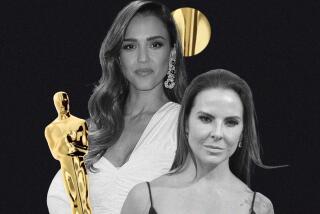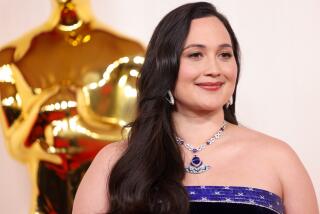Commentary: How we came up with our Diverse 100 list, and why Tina Fey and other white people are on it
When April Reign first tweeted and launched #OscarsSoWhite in 2015, she outlined the problems facing the Academy of Motion Picture Arts and Sciences: that people of diverse background were not being seen in front of and behind the camera, they weren’t being recognized and it was representative of a broader problem in Hollywood.
The hashtag was prescriptive as well: The solution to the lack of diversity is to make use of diverse people and put them in roles that matter — as academy members and movie studio executives.
The hashtag resurfaced earlier this year when the academy announced an all-white slate of acting nominees for the second year in a row. As public discontent spread on social media, prominent celebrities including Spike Lee and Jada Pinkett Smith added their high-profile voices to the conversation. Days later, academy President Cheryl Boone Isaacs and her board of governors swiftly responded, announcing a commitment to diversify its ranks by doubling the number of women and people of color by 2020. By The Times’ estimates however, achieving that goal wouldn’t be easy.
Given that of the academy’s 6,261 voting members, 91% are white and 76% are male, the academy would have to invite at least 375 women and more than 130 people of color each year for the next four years. To put that in context, last year’s class of academy invitees — touted as the largest and most diverse — was 322 people, and the majority was white men.
It was then that we set out to highlight and offer some names of people of diverse background we thought would make great members of the academy and meet the organization’s requirements.
We began with Boone Isaacs’ commitment and expanded it to meet what Reign, a former attorney and managing editor of BroadwayBlack.com, had described in my first interview with her: True diversity means there is room for all women, all people of color, all LGBT and other identified folk as well as the differently abled under the #OscarsSoWhite umbrella. This definition became our guiding light.
Our Diverse 100 also was created with academy members and industry executives in mind. As we covered the dust-up from the nominees and the academy’s response, my colleagues Rebecca Keegan and Josh Rottenberg interviewed countless academy members who anonymously verbalized one of two perspectives: Adding people of color and women to the academy would automatically reduce the quality of films recognized; or there weren’t enough people of diverse background who would meet the varying branches’ steep requirements anyway.
As the attention moved to film studios and their responsibility, business and industry analysts revealed a schism within the studio world as to who was actually responsible. While some agreed with Lee that the men and women (but mostly the men) with greenlighting power were not diverse themselves, and that their selections reflected that, others told Company Town reporter Ryan Faughnder that the process itself was too complicated to truly lay blame on any one specific entity.
Aware of all of this, I reached out to the rest of the film team, including Amy Kaufman, Jeffrey Fleishman, Mark Olsen, film critic Glenn Whipp and an assist from TV reporter Yvonne Villarreal, in search of people they had come across in their reporting who should be academy members. To that list, we added suggestions from the National Hispanic Media Coalition, Outfest and the Pan African Film Festival.
I scoured almost every “Folks to Watch” list uploaded on the Internet. I researched the credits of some of my favorite movies — many of which fall outside the typical “Oscar-worthy” barometer — for folks who had found success in black, independent or LGBT film. I looked at people leading the diversity change on television. I even asked celebrities and award show attendees on some of the red carpets I covered. After removing dozens of duplicates and people who already were academy members, the list stood at nearly 150 people.
From there, we had newsroom conversations about how closely we’d tow line on the academy’s requirements for each branch. We decided that many of the rules were exclusionary — to women, for example, who work in male-dominated fields and are overlooked for projects and promotions, or to people of color who come from lower-income backgrounds that prevented them from taking low- or nonpaying production assistant jobs that eventually led to opportunities to direct a blockbuster movie. As such, the academy’s requirements were just a loose guide.
We also discussed the ever-blurring line between television and film. As Times TV critic Mary McNamara recently wrote, we decided that what has “divided film from television … is fading, often to nonexistence.” And with A-list film talent now finding homes more often on television, “you can’t even call the game by the players,” she said. Work produced for streaming services like Netflix, Hulu and Amazon would qualify.
That brings us to the list. Covering 17 of the academy’s 23 branches, the list of 150 was narrowed to 100 based on the strength of their resumes, their festival and awards performance and the testimony of their peers. We tried to make it racially diverse, taking into account demographics and widespread outcry (as demonstrated on social media with hashtags like Jaya Sundaresh’s #OnlyOnePercent); of the 100, 78 are people of color.
We wanted the representation of women to outweigh that of men, in line with the academy’s commitment, so 60 are women. And it was important to me, as a gay, gender-nonconforming journalist, that LGBT people were present; at least 15 openly identify as such.
Concerns have been raised, however, about one person’s presence on the list. Given what some have deemed as dismissive and problematic responses to accusations of racial insensitivity and racism in Netflix’s “Unbreakable Kimmy Schmidt,” of which she’s a writer and executive producer, Tina Fey’s spot has been questioned. Her space is not an endorsement of what people assume to be her take on diversity. Rather, it demonstrates a “not one of us” mentality that she has faced in the industry as a woman, albeit a white one.
Admittedly, there are aspects of diversity that we missed. In ways subtle, yet still important, we failed to fully embody the vision of diversity under Reign’s #OscarsSoWhite umbrella. The list completely leaves out Native Americans and does not include differently abled people. We welcome reader suggestions to fill both these voids, not as a way to aimlessly profit off the intellectual labor of others, as one Twitter user said, but to uplift people whom moviegoers may be watching, who even we, as members of the media and pop culture machine, are overlooking.
Nonetheless, our Diverse 100 list exists as a solution to the academy’s diversity issue, and a cheat sheet for broader Hollywood. Each man and woman pictured represents the best the industry has to offer when everyone is able to have a seat at the cultural production table. May the conversation continue and this list prove to be unnecessary next year.
MORE FROM ENTERTAINMENT
Drake, Brian Wilson and Blink-182: Your essential summer music guide
Fentanyl: Prince’s cause of death puts potent painkiller in the spotlight
The Smell: A look at the bands that helped define the sound of the punk club
Get your life! Follow me on Twitter: @TrevellAnderson.
More to Read
Only good movies
Get the Indie Focus newsletter, Mark Olsen's weekly guide to the world of cinema.
You may occasionally receive promotional content from the Los Angeles Times.










